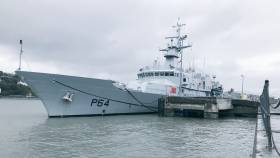Displaying items by tag: Newbuild OPV90
Naval Service Latest Newbuild LÉ George Bernard Shaw Makes Delivery Voyage to Cork Harbour
#NavalService - The newest Irish Naval Service Offshore Patrol Vessel (OPV) LÉ George Bernard Shaw completed a delivery voyage from a UK shipyard to Cork Harbour, writes Jehan Ashmore.
Minister with responsibility for Defence, Mr Paul Kehoe TD, welcomed the arrival of LÉ George Bernard Shaw to the Naval Base in Haulbowline on Thursday. Commenting on the arrival, Minister Kehoe said it demonstrates the Government’s commitment to ongoing investment in the Defence Forces. “In Budget 2019, we have committed to spend an additional €29m on capital projects”
LÉ George Bernard Shaw was built by Babcock Marine's Shipbuilding Yard in Appledore, north Devon, England from where as Afloat previously reported the OPV90 carried out sea-acceptance trails in the Bristol Channel. The trials completed successfully, were attended by representatives from the Department of the Defence and the Defence Forces.
The delivery of LÉ George Bernard Shaw to Cork Harbour completes the current Naval Service ship replacement programme of four new OPV90/P60 class vessels since 2014. The class also dubbed the 'Playwright' sisters, began with leadship LÉ Samuel Beckett in 2014, LÉ James Joyce in 2015 and LÉ William Butler Yeats entering service in 2016. The value of the three-ship contract was €199.4m.
In June 2016 an agreement was reached with Babcock International for the provision of an additional OPV90/P60 to be built also at their Appledore shipyard. The agreed contract value for the further ship is €67m inclusive of VAT. This aligns with the project planning process in place under the White Paper on Defence, which will determine the Defence Organisation’s maritime capability requirements.
The LÉ George Bernard Shaw represents six of the current Irish Naval Service fleet having been built in Appledore.The new OPV will be formally named and commissioned as LÉ George Bernard Shaw at a later date.
The Minister said "The addition of the new ship will bring relief to older vessels and support a planned programme of refit and maintenance. LÉ Roisin and LÉ Niamh will receive significant mid-life refits in the period ahead.”
In recent weeks the issues of low-pay, coupled with staff shortage have been raised. In response Minister Kehoe said the Department will continue to work closely with military management to address challenges in the Naval Service.
“The current strength of the Naval Service is just over 1,000 personnel and is at approximately 92% of its establishment of 1,094. There is ongoing recruitment to the Naval Service. Any challenges in delivering the full outputs across the Defence Forces are being managed and closely monitored by the Defence Forces and the Department of Defence under my direction on a daily basis.”





























































